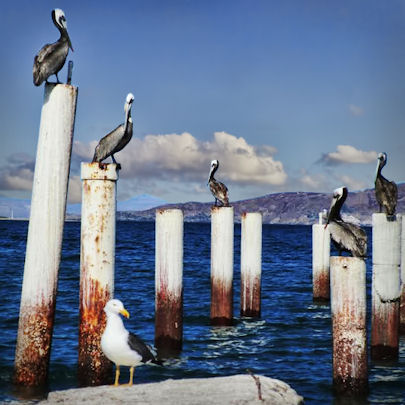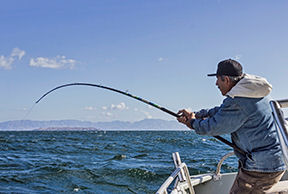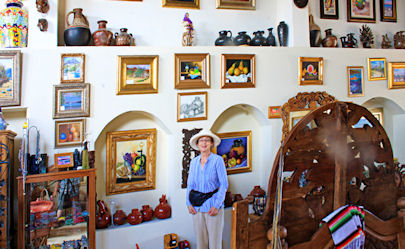 |  |
By Martina

Almost like a moonscape the road into Bahía de Los Ángeles takes you through arroyos once wild with flood waters, but now deep dry canyons. The force of nature has been captured in the very earth itself. Even so, it is a smooth and easy 30 minute drive in from Highway 1, with just a few sections of road under repair. Then the long sweeping shoreline and the azure-blue water of Bahía de Los Ángeles opens out before you. Off shore a backbone of volcanic ridge pushes up out of the water and is joined by many islands. The small quiet town is sandwiched between the bay and Sierra La Libertad, 1300 feet of folded and sculpted mountain. LA Bay, as state side travelers often called it, is a community of very hardy folks. Their lives are wrapped around the sea and fishing. A few foreign residents live in a fairly stark landscape, called "Gringa Point." The only paved road runs through town. All other roads out to the water front are sandy and wind-swept.
I planned a two night stay at Guillermo’s Place that is a well-known destination for sports fishermen. It was the time of siesta so what was there to do but sit on the patio with a frosty margarita and watch the pangueros go in and out of the bay. Suddenly, my eye caught a photo op in the late afternoon sunshine. Against the deep blue water, pelicans were claiming their own private lookouts on top of old pier pilings. I got the shot and let out a whoop, scaring the sea gull away. I was to meet with Guillermo for an interview, however I was told he was not back from the rancho. I used the waiting time to get settled into my room. This little rustic hotel is the only lodging right on the waterfront and near the new launching ramp. There are several other hotels west of the main road. I walked the shore line with camera in hand and returned to the restaurant at sunset. The menu featured Guillermo’s favorite; huge bay scallops wrapped in bacon, which were to die for!

When Guillermo arrived, we sat outside on the dark patio. I realized I was meeting a very real ranchero and someone who knew this land and sea like no other. We participated in a traditional shot of tequila. He was a lively storyteller, weaving stories of his youth with good humor. Bill Viele, who took the photo of Guillermo on the fishing boat, tells this story while he was aboard. Guillermo had a big Yellowtail on his line. It was putting up a fierce fight and snapped the rod like a twig. Undaunted, Guillermo grabbed the loose fishing line with his bare hands and hauled that fighting creature in. Now that is a true fish story. As we said goodnight, Guillermo assured me Luz Galvan, his sister, would be back soon enough to open her art gallery before I left.
Since Luz had not yet returned, the next day I headed off to the museum. I was instantly impressed as I ventured inside. As luck would have it, the founder and curator of the museum, Carolina Espinoza, welcomed me. I told her this was way beyond my expectations and asked how it came to be? Carolina nodded knowingly and said that 43 years ago she had gone to the local dump and found valuable artifacts that had been thrown away. Now, with time and contribution, it is a significant collection of historic value. Glass cases with Cochimi Indian artifacts displayed how they lived and thrived before they were “discovered.” The rancho and its fine leather work and the gold rush period were well represented. Hanging overhead was a full size skeleton of a one year old gray whale from the bay. A section of actual dried baleen was fascinating. These horse hair-like strands, nearly two feet long, strain more than 5,000 pounds of krill and plankton each day.

Bahía de Los Ángeles is now a protected biosphere of almost 1500 square miles. All 16 islands are part of the reserve and have a diverse and unique marine population which includes many endangered species like the whale shark, fin whales and five species of sea turtle. An interesting story is that a marine biologist set up a research station to study the sea turtles here. In 1995 because of his work, it was reported that his 213 pound Loggerhead turtle, "Rosita," had made it all the way to the coast of Japan, establishing the Loggerhead’s amazing migration pattern for the first time.
Finally I had the opportunity to meet Luz Galvan. Swinging open heavy beautifully carved wooden doors, she welcomed me into her gallery. Her soft ethereal nature made me feel as if I was meeting one of the angels of the bay. I was literally stunned by what I saw. It was as though I was entering a cathedral for the arts out in the middle of nowhere. The walls were covered from floor to ceiling with her paintings. What makes Luz’s work so amazing is gift of versatility. The realism in acrylics makes you think you can take a bite out of the apple or walk right into the desert scene. Then she shows you her water colors in impressionism. I believe there is nothing she cannot paint. Besides her own work, the gallery is filled with the finest art, crafts, pottery and jewelry from all over Mexico. Overwhelmed by Luz’s commitment to beauty and her prolific work, I was deeply touched. Luz put her hand over her heart, “I paint what I feel,” she smiled a Mona Lisa smile. That feeling touches everything in her quite remarkable gallery.


Contact and travel information:
Martina's email: mteomaya(at)gmail.com